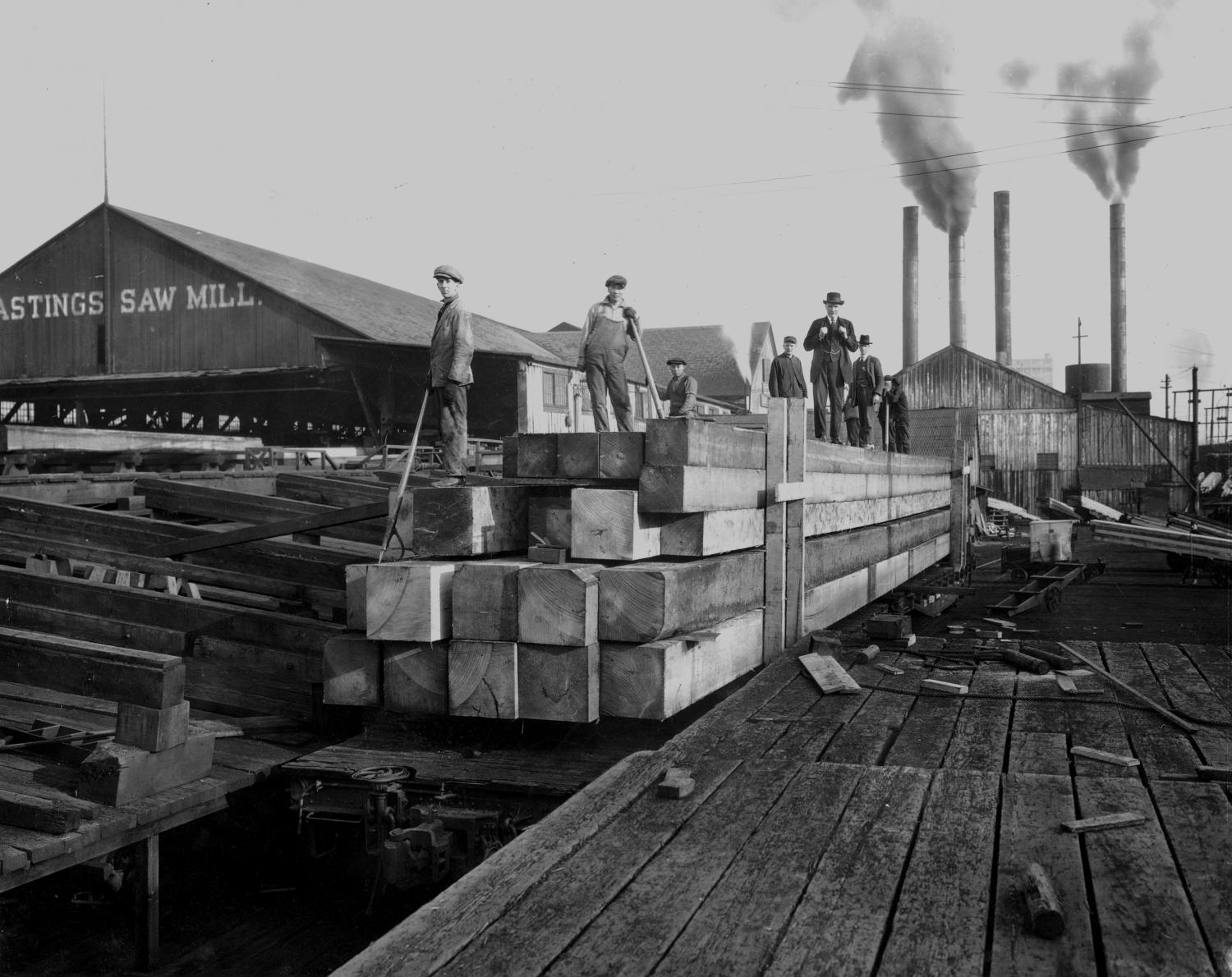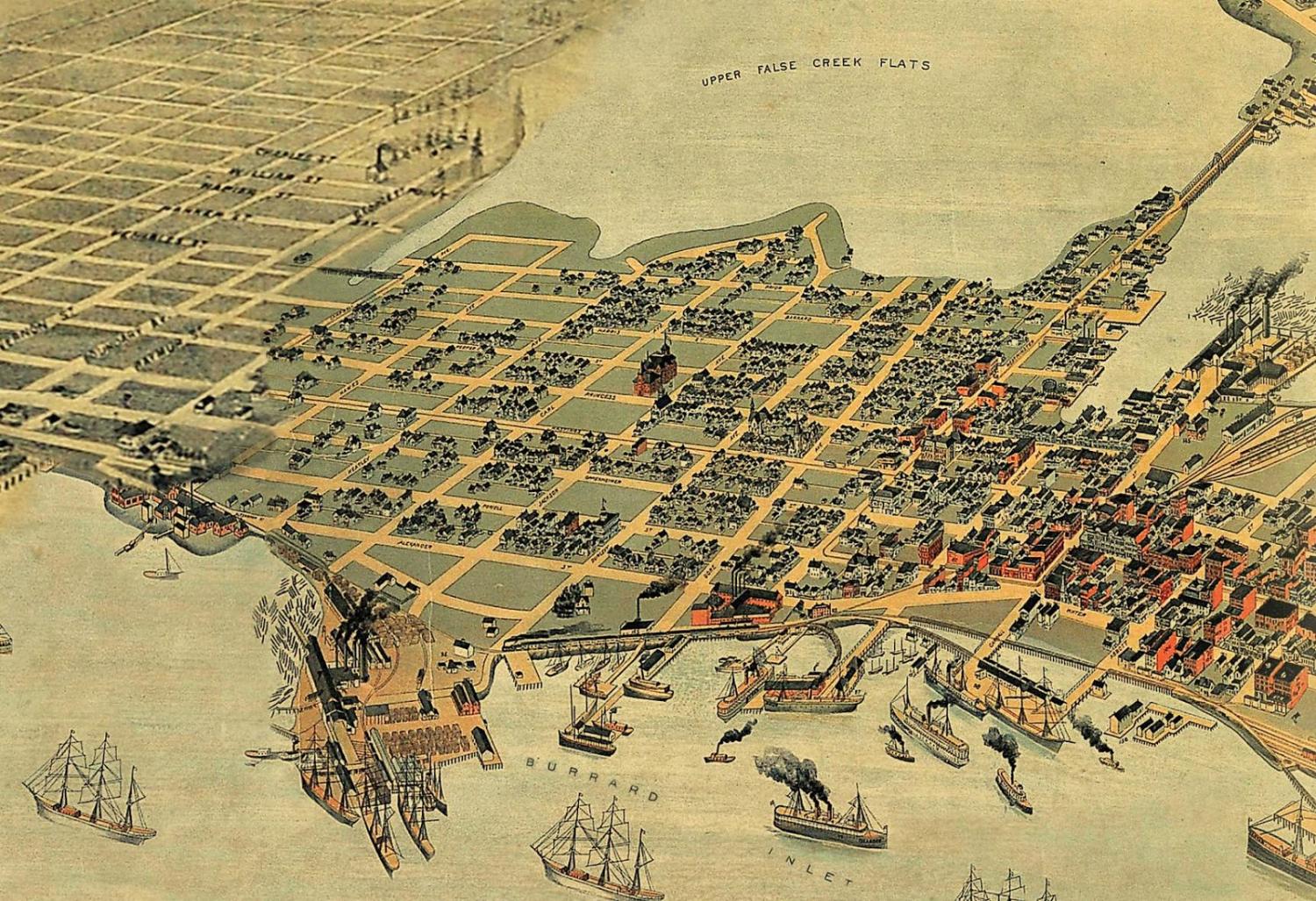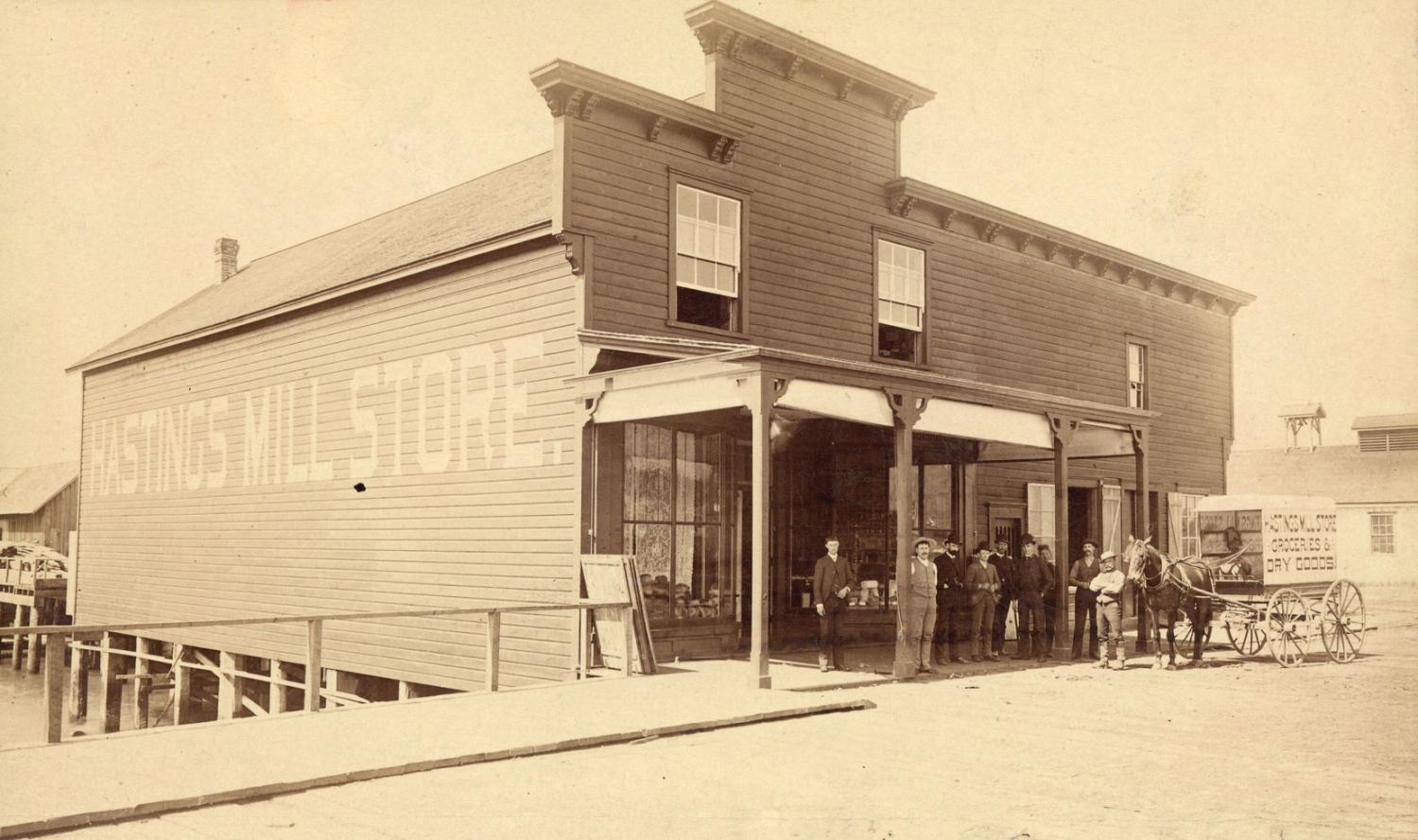Hastings Sawmill Opens
Vancouver’s oldest building watches a city grow from the ground up
Date: 1865
In the mid-1860s, a British capitalist named Edward Stamp opened a steam-powered sawmill at the northern tip of Dunlevy Street, now Dunlevy Avenue, near Vancouver’s Gastown. For thousands of years, this stretch of shoreline on Burrard Inlet had served as an important seasonal camp and trading hub for the Coast Salish people. The Musqueam called it Q’umq’umal’ay because of the many broad-leafed Maples that once grew there. Today, Canada’s largest port dominates this strip of waterfront.
Soon after Stamp’s Mill opened, it began shipping lumber to destinations as far away as China and Australia. As was the norm in those days, Stamp built a company store to serve his employees’ various needs, be they flannel underwear, scented hair oil or 150-proof “medicines.” After the sawmill changed hands in 1870, it gained its famous moniker, Hastings Mill, a tribute to George Fowler Hastings, a vice-admiral in the British Royal Navy. Over the next few decades, the settlement then known as Granville rose up around it.
The Hastings Mill Store was home to the fledgling town’s first post office, library and community centre. Its first school, a one-room structure local parents helped build, opened at the mill in 1872. Fourteen years later, Granville incorporated and became the City of Vancouver, named after the British explorer who had surveyed the coast nearly a century earlier. A transcontinental railway would soon connect the young municipality to the rest of Canada. Vancouver’s residents, estimated to number around one thousand, looked to the future with stars in their eyes.
Then, on a sweltering June day, only two months after the city was created, the Great Fire of 1886 destroyed much of Vancouver. An untold number died; hundreds lost their homes. But the blaze spared the sawmill, which became a refuge for many that day. As Vancouver lay in ashy ruin, the company store opened its doors as a makeshift hospital and morgue. Richard H. Alexander, the mill’s then-owner, reportedly offered free lumber to all those forced to rebuild.
The mill remained Vancouver’s largest industrial enterprise until the end of the First World War. A decade later, it was gone. By the mid-1920s, the city’s economy was no longer wholly dependent on forestry, and Vancouver was well on its way to becoming Canada’s third-largest city. In 1927, the sawmill’s owners sold the land to the federal government. Two years later, the mill and the orbit of buildings that had to come to surround it were demolished — all but the company store.
Thanks to a group of settler women named the Native Daughters of British Columbia, Vancouver’s oldest standing building, two storeys of rough-sawn cedar, narrowly avoided a wrecking ball. On July 29, 1930, the Old Hastings Mill Company Store was towed by barge and dropped at a small park on the north end of Alma Street in the city’s Point Grey neighbourhood. The Native Daughters transformed the building into a museum a couple of years later. It remains the Old Hastings Mill Store Museum to this day.
Sources:
- "1885-1891." The History of Metropolitan Vancouver, https://www.vancouverhistory.ca/chronology2.html. Accessed 05-22-21.
- Atkin, John. "The Old Hastings Mill Store Museum." Walking Tours of Vancouver, http://www.johnatkin.com/images/hastings.htm. Accessed 22 May 2021.
- "Chapter One: 1872 – 1890." Vancouver School Board Archives & Heritage, 3 June 2015, https://blogs.vsb.bc.ca/heritage/2015/06/03/chapter-one-1872-1889/.
- Davis, Chuck. "Vancouver." Encyclopedia Brittanica, 11 Feb. 2019, https://www.britannica.com/place/Vancouver/additional-info#history.
- Krieg, Oona. "Gentricide." CiTR, 11 Apr. 2017, https://www.citr.ca/discorder/april-2017/gentricide/.
- Lamb, W. Kaye. "Stamp, Edward." Dictionary of Canadian Biography, vol. 10, University of Toronto/Université Laval, 1972, http://www.biographi.ca/en/bio/stamp_edward_10E.html.
- Mackie, John. "Original 1865 Ledger from Hastings Mill to Be Auctioned." Vancouver Sun, 3 Feb. 2020, https://vancouversun.com/news/local-news/original-1865-ledger-from-hastings-mill-to-be-auctioned.
- ---. "This Week in History: 1931: Vancouver Becomes Canada’s Third-Largest City." Vancouver Sun, 11 Aug. 2018, https://vancouversun.com/news/local-news/this-week-in-history-1931-vancouver-becomes-canadas-third-largest-city.
- Matthews, Major J. S. Early Vancouver. Vol. 3, City of Vancouver, 2011, https://archives.vancouver.ca/projects/EarlyVan/SearchEarlyVan/Vol3pdf/MatthewsEarlyVancouverVol3_OliverMHocking.pdf.
- ---. Early Vancouver. Vol. 2, City of Vancouver, 2011, http://former.vancouver.ca/ctyclerk/archives/digitized/earlyvan/searchearlyvan/Vol2pdf/MatthewsEarlyVancouverVol2_IndianVillagesLandmarks.pdf.
- "Powell Street Area (Nihonmachi)." Heritage Vancouver, 2017, http://heritagevancouver.org/top10-watch-list/2017/9-powell-street-area-nihonmachi/.
- Smith, Lisa. Vancouver Is Ashes: The Great Fire of 1886. 2014.
- Snyders, Tom, and Jennifer O’Rourke. Namely Vancouver: A Hidden History of Vancouver Place Names. Arsenal Pulp Press, 2000.
- "The Hasting Mills Store: Vancouver’s Oldest Surviving Building." Below B.C., 27 Nov. 2014, https://belowbc.wordpress.com/2014/11/27/the-hasting-mills-store-vancouvers-oldest-surviving-building/.
- Underwood, Jacqui. "History." Old Hastings Mill Store Museum, 2009, https://hastingsmillmuseum.ca/our-history.
- "Vancouver Harbour Commissioners." City of Vancouver Archives, https://searcharchives.vancouver.ca/vancouver-harbour-commissioners-5.
- Vancouver Moving Theatre, et al. Storyweaving: Weaving First Nation Memories from the Past into the Future. Vancouver Aboriginal Friendship Centre, May 2012, https://open.library.ubc.ca/cIRcle/collections/ubccommunityandpartnerspublicati/52387/items/1.0380041. University of British Columbia Open Collections.
- Woods, Derek. "The Hastings Mill as Ecological Machine: Vancouver’s Origin Story." Platypus, 19 May 2015, http://blog.castac.org/2015/05/hastings-mill/.





